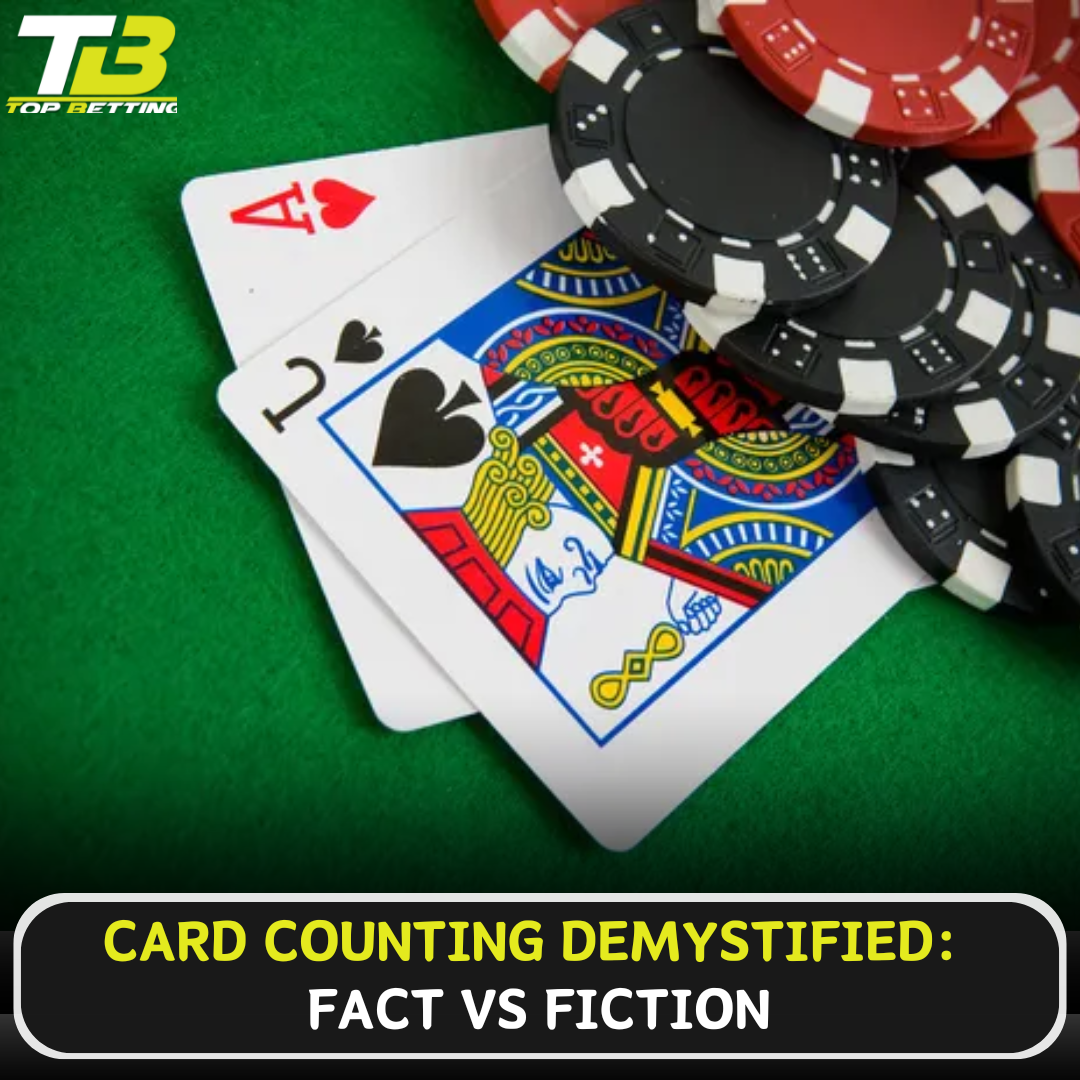
Card Counting Demystified Fact vs Fiction
Card counting is often depicted in popular media as a high-stakes, glamorous activity used by savvy gamblers to outwit casinos and win big. However, there’s a significant gap between Hollywood portrayals and the reality of card counting in blackjack. This article aims to clarify what card counting really involves, dispel common myths, and provide an accurate understanding of how it works.
Understanding Card Counting
What is Card Counting?
Card counting is a technique used in blackjack to determine whether the next hand is likely to give an advantage to the player or the dealer. It’s based on tracking the ratio of high cards (10s, face cards, and Aces) to low cards (2 through 6) that have been dealt. The idea is that a deck rich in high cards is advantageous to the player because it increases the likelihood of getting a blackjack (a 10-value card and an Ace) and of the dealer busting.
The Reality of Card Counting
1. Card Counting is Legal
Contrary to popular belief, card counting is legal. It involves using mental math and memory to keep track of the cards dealt and is not considered cheating. However, casinos view it as a breach of their rules and may ask card counters to leave or ban them from playing blackjack. While it’s not illegal, it’s a strategy that casinos actively try to prevent.
2. It Doesn’t Guarantee Wins
Card counting doesn’t ensure success. It provides a statistical edge, typically around 1-2% over the house. This advantage means that while card counters are more likely to win in the long run, they can still experience losing streaks. Variance and luck play significant roles, and there are no guarantees of winning.
3. It’s Not Just for Geniuses
Card counting is not reserved for mathematical prodigies. With practice, average players can become proficient. The skill required includes basic arithmetic and memory, not extraordinary intellect. Systems like the High-Low system simplify the process, making it accessible to many players who are willing to put in the time.
4. Casinos Can Detect Card Counters
Casinos employ various methods to detect card counters, including surveillance, tracking betting patterns, and analyzing player behavior. While detection is possible, not all counters are caught. Successful counters often use camouflage techniques, like varying their betting patterns and playing other games, to avoid suspicion.
5. It’s Not Effective in Online Casinos
Online casinos game often use continuous shuffling machines or frequent deck changes to thwart card counting. These methods ensure that the deck is reshuffled after every hand or round, making it impossible to keep an accurate count of the cards. Therefore, traditional card counting techniques are largely ineffective in online settings.
Common Myths
1. “Card Counting is Cheating”
This is false. Card counting is a legal technique that uses skills rather than technological aids or deception. Cheating typically involves dishonest actions like using hidden devices or colluding with other players, which is distinct from the legitimate practice of card counting.
2. “Card Counters Always Win”
This is an exaggeration. While card counting can provide a statistical advantage, it doesn’t guarantee a win. Variance means that even with an advantage, players can face significant losses in the short term.

3. “Casinos Can’t Do Anything About It”
In reality, casinos actively combat card counting. They employ sophisticated surveillance systems and train staff to spot suspicious behavior. They also adjust rules and use multiple decks to reduce the effectiveness of card counting.
4. “Card Counting is Too Difficult”
While card counting requires practice and concentration, it is not excessively difficult. Many players can master basic counting techniques with dedication. Advanced systems are more complex but are not necessary for all counters.
How It Works
- Assigning Values: Card counters assign point values to each card:
- High Cards (10s, face cards, Aces): -1
- Low Cards (2 through 6): +1
- Neutral Cards (7, 8, 9): 0
- Running Count: As cards are dealt, the counter maintains a “running count” by adding or subtracting the assigned values.
- True Count: To adjust for the number of decks in play, the running count is converted to the “true count” by dividing it by the number of decks remaining.
- Bet Sizing: A higher true count indicates a higher proportion of high cards left in the deck, which is advantageous to the player. Players adjust their bets accordingly, betting more when the count is high and less when it is low.
Common Myths and Misconceptions
1. “Card Counting is Illegal”
- Fact: Card counting is not illegal. It is a strategy that relies on mental math and memory. However, casinos view it as a breach of their rules and may ask counters to leave or ban them from playing blackjack. They have the right to refuse service to anyone.
2. “Card Counting Guarantees Wins”
- Fact: Card counting doesn’t guarantee wins; it only gives players a statistical advantage. Even with perfect card counting, variance means that players can experience losing streaks. The edge provided by card counting is typically around 1-2%, which means that while it improves the odds, it doesn’t ensure victory.
3. “Card Counting is Only for ‘Geniuses’”
- Fact: While card counting requires practice and skill, it’s accessible to many people. It doesn’t require extraordinary intelligence but rather a good memory and the ability to perform basic arithmetic quickly. With practice, even average players can become proficient at it.
4. “Casinos Can Detect Card Counters Easily”
- Fact: Casinos use various methods to identify potential card counters, including surveillance, analyzing betting patterns, and employing experienced dealers. However, many counters remain undetected for extended periods. The most successful counters are those who blend in, avoid obvious betting patterns, and use camouflage strategies.
5. “Card Counting Only Works in Casinos”
- Fact: Card counting is primarily associated with casinos, but it can be applied in any environment where blackjack is played. This includes home games and online platforms. However, online casinos often use continuous shuffling machines or frequent deck changes to thwart card counting.
Strategies for Card Counting
1. Basic Strategy: Before applying card counting, players should master basic blackjack strategy, which involves making optimal decisions based on the dealer’s upcard and the player’s total. Card counting complements basic strategy but does not replace it.
2. High-Low System: The high-low system is one of the simplest and most popular card counting systems. It assigns values as mentioned earlier and is effective for most players. Other systems, like the Omega II or Wong Halves, offer more precision but are more complex.
3. Keeping a Balanced Count: Some advanced strategies involve more complex counting systems, which provide better accuracy but require more practice. These systems track multiple values or “balanced” counts to give a more detailed picture of the deck composition.
4. Camouflage: Successful card counters often use camouflage techniques to avoid detection. This can include varying bet sizes less predictably, using a team approach (e.g., one person counts while another places bets), or even playing other casino games to blend in.
Legal and Ethical Considerations
1. Casinos’ Rights: Casinos have the right to refuse service to anyone they suspect of card counting. They use various tools and methods to detect and prevent card counting, including surveillance systems and tracking software.
2. Ethics: While card counting is legal, its ethics are often debated. Some view it as a clever use of skill and knowledge, while others see it as an unfair exploitation of the casino’s rules. From a legal standpoint, it’s not cheating but rather using available information to gain an advantage.
The Impact of Technology
1. Online Casinos: Many online casinos use continuous shuffling machines or virtual decks, which make traditional card counting methods ineffective. The frequent reshuffling of cards removes the advantage that card counters rely on.
2. Casino Surveillance: Casinos have invested heavily in surveillance and technology to detect card counters. This includes using sophisticated software to analyze betting patterns and player behavior. Despite these advancements, some skilled counters still manage to evade detection.
3. Countermeasures: Casinos continually adapt their countermeasures against card counters. This includes changes in game rules, deck penetration (how many cards are dealt before reshuffling), and the use of multiple decks.
Famous Card Counting Stories
1. MIT Blackjack Team: Perhaps the most famous card counting team, the MIT Blackjack Team used sophisticated techniques and a team approach to win millions at casinos. Their story was popularized in the book “Bringing Down the House” and the movie “21.”
2. Ken Uston: A prominent card counter and author, Ken Uston was known for his aggressive strategies and legal battles with casinos. His books and public appearances contributed to the myth and mystique surrounding card counting.
3. Edward Thorp: Often credited as the pioneer of card counting, Edward Thorp’s book “Beat the Dealer” introduced card counting to the public. His work laid the foundation for modern card counting techniques and strategies.
Conclusion

Card counting is a legitimate strategy that can provide players with an edge in blackjack, but it is often misunderstood and surrounded by myths. While it is not illegal, it is highly scrutinized by casinos, and successful counters must employ discretion and skill. The reality of card counting is more nuanced than popular media suggests, involving a blend of mathematical strategy, practice, and an understanding of casino dynamics. For those interested in pursuing card counting, a thorough understanding of its principles and a strategic approach are essential to navigate its challenges effectively.











